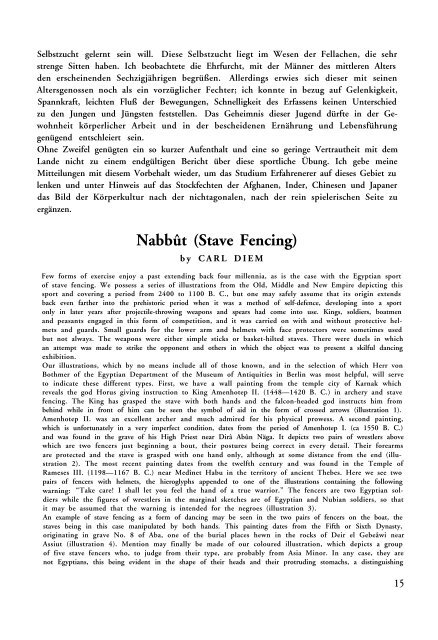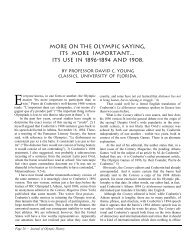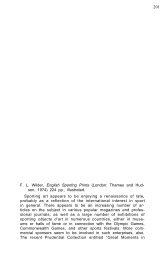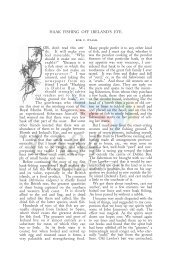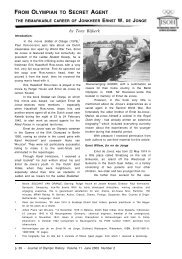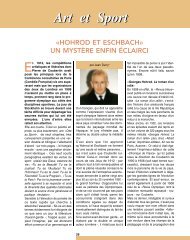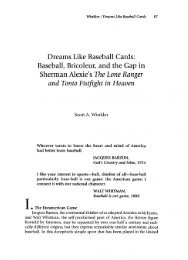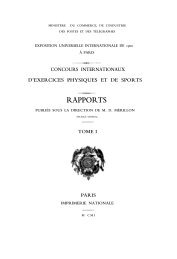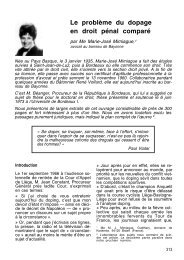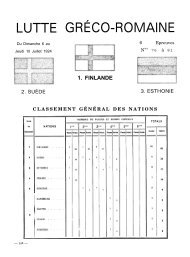Nabbût (stave fencing).
Nabbût (stave fencing).
Nabbût (stave fencing).
Create successful ePaper yourself
Turn your PDF publications into a flip-book with our unique Google optimized e-Paper software.
Selbstzucht gelernt sein will. Diese Selbstzucht liegt im Wesen der Fellachen, die sehr<br />
strenge Sitten haben. Ich beobachtete die Ehrfurcht, mit der Männer des mittleren Alters<br />
den erscheinenden Sechzigjährigen begrüßen. Allerdings erwies sich dieser mit seinen<br />
Altersgenossen noch als ein vorzüglicher Fechter; ich konnte in bezug auf Gelenkigkeit,<br />
Spannkraft, leichten Fluß der Bewegungen, Schnelligkeit des Erfassens keinen Unterschied<br />
zu den Jungen und Jüngsten feststellen. Das Geheimnis dieser Jugend dürfte in der Gewohnheit<br />
körperlicher Arbeit und in der bescheidenen Ernährung und Lebensführung<br />
genügend entschleiert sein.<br />
Ohne Zweifel genügten ein so kurzer Aufenthalt und eine so geringe Vertrautheit mit dem<br />
Lande nicht zu einem endgültigen Bericht über diese sportliche Übung. Ich gebe meine<br />
Mitteilungen mit diesem Vorbehalt wieder, um das Studium Erfahrenerer auf dieses Gebiet zu<br />
lenken und unter Hinweis auf das Stockfechten der Afghanen, Inder, Chinesen und Japaner<br />
das Bild der Körperkultur nach der nichtagonalen, nach der rein spielerischen Seite zu<br />
ergänzen.<br />
<strong>Nabbût</strong> (Stave Fencing)<br />
by CARL DIEM<br />
Few forms of exercise enjoy a past extending back four millennia, as is the case with the Egyptian sport<br />
of <strong>stave</strong> <strong>fencing</strong>. We possess a series of illustrations from the Old, Middle and New Empire depicting this<br />
sport and covering a period from 2400 to 1100 B. C., but one may safely assume that its origin extends<br />
back even farther into the prehistoric period when it was a method of self-defence, developing into a sport<br />
only in later years after projectile-throwing weapons and spears had come into use. Kings, soldiers, boatmen<br />
and peasants engaged in this form of competition, and it was carried on with and without protective helmets<br />
and guards. Small guards for the lower arm and helmets with face protectors were sometimes used<br />
but not always. The weapons were either simple sticks or basket-hilted <strong>stave</strong>s. There were duels in which<br />
an attempt was made to strike the opponent and others in which the object was to present a skilful dancing<br />
exhibition.<br />
Our illustrations, which by no means include all of those known, and in the selection of which Herr von<br />
Bothmer of the Egyptian Department of the Museum of Antiquities in Berlin was most helpful, will serve<br />
to indicate these different types. First, we have a wall painting from the temple city of Karnak which<br />
reveals the god Horus giving instruction to King Amenhotep II. (1448—1420 B. C.) in archery and <strong>stave</strong><br />
<strong>fencing</strong>. The King has grasped the <strong>stave</strong> with both hands and the falcon-headed god instructs him from<br />
behind while in front of him can be seen the symbol of aid in the form of crossed arrows (illustration 1).<br />
Amenhotep II. was an excellent archer and much admired for his physical prowess. A second painting,<br />
which is unfortunately in a very imperfect condition, dates from the period of Amenhotep I. (ca 1550 B. C.)<br />
and was found in the grave of his High Priest near Dirâ Abûn Näga. It depicts two pairs of wrestlers above<br />
which are two fencers just beginning a bout, their postures being correct in every detail. Their forearms<br />
are protected and the <strong>stave</strong> is grasped with one hand only, although at some distance from the end (illustration<br />
2). The most recent painting dates from the twelfth century and was found in the Temple of<br />
Rameses III. (1198—1167 B. C.) near Medînet Habu in the territory of ancient Thebes. Here we see two<br />
pairs of fencers with helmets, the hieroglyphs appended to one of the illustrations containing the following<br />
warning: “Take care! I shall let you feel the hand of a true warrior.” The fencers are two Egyptian soldiers<br />
while the figures of wrestlers in the marginal sketches are of Egyptian and Nubian soldiers, so that<br />
it may be assumed that the warning is intended for the negroes (illustration 3).<br />
An example of <strong>stave</strong> <strong>fencing</strong> as a form of dancing may be seen in the two pairs of fencers on the boat, the<br />
<strong>stave</strong>s being in this case manipulated by both hands. This painting dates from the Fifth or Sixth Dynasty,<br />
originating in grave No. 8 of Aba, one of the burial places hewn in the rocks of Deir el Gebeâwi near<br />
Assiut (illustration 4). Mention may finally be made of our coloured illustration, which depicts a group<br />
of five <strong>stave</strong> fencers who, to judge from their type, are probably from Asia Minor. In any case, they are<br />
not Egyptians, this being evident in the shape of their heads and their protruding stomachs, a distinguishing<br />
15
feature commonly employed by the Egyptians to designate foreign races. The outside man bears the symbol<br />
of a guild, the wrestlers’ crest upon a staff, as an indication that they are members of a sport club<br />
or professional competitive guild. The painting was found in the grave of Tjanung in Thebes, dating from<br />
the period of Thutmos IV. (1490—1411 B. C.).<br />
Herodotus has also provided us with an account of these competitions (II, 63). In the course of a religious<br />
ceremony in connection with a cult celebration in Papremis about 1000 men engaged in <strong>stave</strong> <strong>fencing</strong><br />
at sunset, this symbolizing the defence of the entrance to the temple against the god of war. Herodotus<br />
asserts that the warriors beat one another to the point of death, although Egyptian chroniclers deny that<br />
anyone was seriously injured.<br />
Thus we have multiple examples of ancient participation in a sport which is carried on still today in a<br />
very similar manner. During a short sojourn in Egypt, I was able on several occasions to observe <strong>stave</strong><br />
<strong>fencing</strong>. A former student of mine in the German School of Physical Culture who is now gymnastic inspector<br />
in Cairo, Ahmad Marzouk, entertained me one fine afternoon in his tent at the edge of the Libyan<br />
Desert, and upon my expressing a wish to see <strong>stave</strong> <strong>fencing</strong>, he summoned several youths from the nearest<br />
rural village who gladly gave a performance in this sport. The Director of the German Archaeological<br />
Institute in Cairo, Professor Junker, invited us several days later to an afternoon tea at the foot of the<br />
Pyramids of Giza, where he had excavated several extremely interesting and instructive Mastabas. From<br />
the German, American and Egyptian excavating groups he had assembled the best <strong>stave</strong> fencers, and in<br />
their exhibition of this sport we saw unusual performances by different age groups from 16 to 60 years.<br />
Youths of ten even tried their ski but the result in this case was scarcely successful. The boatmen on<br />
our Nile steamer also arranged a programme of native sports and games, among them the barber pranks<br />
so popular in the Orient. The displays of physical strength and ability naturally included <strong>stave</strong> <strong>fencing</strong>.<br />
This sport occupies a prominent place in the recreational pursuits of the “Fellach”, or Egyptian peasant, who<br />
has retained his traditions and customs throughout the millennia. Races and nations have swept over Egypt<br />
— the still mysterious Hyksos, the Ethiopians, Persians, Greeks, Romans and then the Arabs and Turks,<br />
not to speak of the French invasion under Napoleon —, but the Egyptian peasant, who often enough has<br />
lived under foreign dominion, has remained sturdy and unchanged. His features today do not differ in the<br />
slightest from those we encounter on the walls of the Pyramids. In his diligent and unpretentious work<br />
of cultivating the banks of the Nile, the Egyptian reveals time and again his ancient racial heritage, and his<br />
customs, clothing, farming implements, food and habits have not altered. Tall, slender figures with unusual<br />
strength of limb despite apparently slight muscular development, small heads and complete lack of obesity<br />
characterize the Egyptian of today, who is sturdy and agile, with the same grace of movement one encounters<br />
in the highly life-like representations in ancient paintings. Professor Junker described to us the<br />
unusual physical ski and agility of the “Fellachs”, declaring that they descend vertical grave shafts to a<br />
depth of as much as 40 metres with only the small grooves for their toes and fingers which their ancient<br />
predecessors notched for the same reason. They are tireless and dependable in their work. Particular praise<br />
was devoted to the “Fellachs” of Upper Egypt, who have remained least contaminated from an ethnical<br />
point of view.<br />
In wandering through the country-side, the “Fellach” carries a sturdy straight stick about 1.25 metres long,<br />
sometimes even longer. It is carved out of heavy, seasoned oak imported from Southern Asia Minor, which<br />
was also the source of ship masts and similar sticks in ancient times. This stick is the weapon used in<br />
<strong>fencing</strong>. When a pair of fencers decide to test their prowess, the spectators, who are usually on hand, squat<br />
in a circle around the performers. Clothing remains unchanged, the contestants retaining their wide cotton<br />
trousers and the white shirt which often reaches to the ankles. A cape is frequently worn in addition<br />
thereto, while the head is encased in a white turban wound about the red fez. The <strong>stave</strong> is grasped with<br />
both hands, which are spread wide apart for defence purposes or drawn to one end when hammer-like<br />
blows are delivered. In the course of <strong>fencing</strong>, the <strong>stave</strong> is often manipulated with one hand if greater rapidity<br />
of motion can thus be acquired, and in such cases the resemblance to the ancient illustrations is complete.<br />
The <strong>fencing</strong> bout involves unusual rapidity of movement, and in this respect quite exceeds sabre <strong>fencing</strong>.<br />
The two opponents manœuvre about one another in a wide circle, advancing and retreating, dodging and<br />
leaping, stooping and stretching, so that every muscle of the body is brought into play. There is a great<br />
amount of parrying and manœuvring; at times hard blows are rained upon the earth or a series of thrusts<br />
follow one another in quick succession as in prime, changing then with lightning-like rapidity to tierce or<br />
quarte. The unusual feature about this sport is the fact that blows are rained with extreme violence only<br />
when the opponent is in a position to parry. Should his defence fail, the blow is checked at the final moment<br />
and the opponent is only lightly touched as an indication that the manœuvre has succeeded. In this manner<br />
16
the duel takes on the character of a dance, and the graceful leaps and movements of the fencers are actually<br />
somewhat terpsichorean in character.<br />
In all of the exhibitions which I was privileged to witness I did not see one blow administered with violence.<br />
Painful injuries are sustained only when the parrying is unskilful and blows land on the fingers of the defending<br />
fencer. In spite of the vehemence with which these duels are carried out they always remain chivalrous<br />
and sporting, and are usually concluded at a sign from one or both fencers or from the next waiting pair.<br />
The case of the ten year old youths, who obviously lost their tempers and began to flay one another, indicates<br />
that this sportsmanlike control must be learned. It lies in the character of the “Fellach”, who adheres<br />
strictly to tradition. I observed the reverence with which middle-aged men greeted those of sixty. Even<br />
those who had passed the three-score mark proved to be excellent fencers when competing with others of<br />
like age, and as regards agility, elasticity, lightness of movement and rapidity of action, I could discern no<br />
difference between them and their more youthful colleagues. The secret of this permanent youthfulness is<br />
probably concealed in the daily physical labour and in the modest nourishment and manner of living.<br />
It is true that so short a sojourn and such a slight acquaintanceship with the country are scarcely adequate<br />
to qualify one for compiling a detailed report upon this form of physical exercise. I therefore present my<br />
comments with this reservation, hoping in so doing to attract those of wider experience to this field of study,<br />
and, by referring to <strong>stave</strong> <strong>fencing</strong> among the Aghans, Indians, Chinese and Japanese, to extend the field of<br />
physical culture in its non-combative but purely recreational aspect.<br />
Kunst und Amateurismus<br />
Von CARL DIEM<br />
Die olympischen Kämpfe stehen unter dem Gesetz des Amateurparagraphen, und nur,<br />
wer den Sport als Liebhaberei betreibt, kann olympische Ehren gewinnen. Doch gibt es eine<br />
Ausnahme : den olympischen Kunstwettbewerb. Hier sind alle Künstler aufgerufen; diese<br />
widmen sich ihrer Kunst allermeistens so, daß sie ihr ganzes Dasein ausfüllt. Demgemäß<br />
müssen die Künstler in der Regel aus der Ausübung ihrer Kunst auch ihren Lebensunterhalt<br />
verdienen. Sportlich gesprochen, würden es also ,,Professionals“ sein.<br />
Kann man ihre Teilnahme im olympischen Wettstreit rechtfertigen ?<br />
Ich habe solche Fragen oft in der Aussprache über die olympischen Gesetze auftauchen<br />
hören, selbst im Kreise der olympischen Führerschaft, und sie wurde oft genug verneinend<br />
beantwortet; hier klaffe eben ein logischer Fehler in den Bestimmungen!<br />
Ich wage dies zu bestreiten. Der Unterschied liegt im Wesen beider Inhalte: dem der Kunst<br />
und dem des Sports, und ist daher berechtigt!<br />
Bevor ich dies begründe, sei an die Entstehung der Kunstwettbewerbe erinnert. Dies geschah<br />
auf der von Coubertin am 23. Mai 1906 nach Paris einberufenen ,,beratenden Versammlung”.<br />
Coubertin entwickelte damals in der Eröffnungsansprache sein Programm.<br />
Sem Ziel war, die Werte, die der Sport aus der Kunst ziehen könnte, für diesen zu gewinnen,<br />
den Sport durch die Kunst zu veredeln (pour en bénéficier et les Sports ennoblir). Er wollte<br />
erreichen, daß die Künstler selbst Sport treiben und daraus die Erlebnisse für ihre Kunst<br />
ziehen sollten. Alle drei, die Athleten, die Zuschauer und die Künstler, sollten wieder<br />
,,Eurythmie“, schöne Bewegung lernen. Kurz, Coubertin dachte an echte, volle Kunst,<br />
er dachte an die großen, reifen Künstler, und er versprach sich von ihrem Einfluß einen<br />
neuen Glanz für die Olympischen Spiele, für den Sport überhaupt und für das menschliche<br />
Geschlecht in der Erweckung eines neuen Sinns für die schöne Bewegung im Leben,<br />
nicht nur für das Festgehaltene der Bewegung, das schöne Stehende, das Bild, die Skulptur,<br />
17
Stockfechten an den Pyramiden von Gîza.<br />
Kampfbeginn ein- und zweihändig.<br />
Bild 3: Täuschung durch Schlag auf den Boden.<br />
Aufnahmen : Carl Diem
Stockfechten an den Pyramiden von Gîza.<br />
Bild 7—9 beidhändige Abwehr.<br />
Bild 9 : Zehnjährige Knaben.<br />
Aufnahmen: Carl Diem


